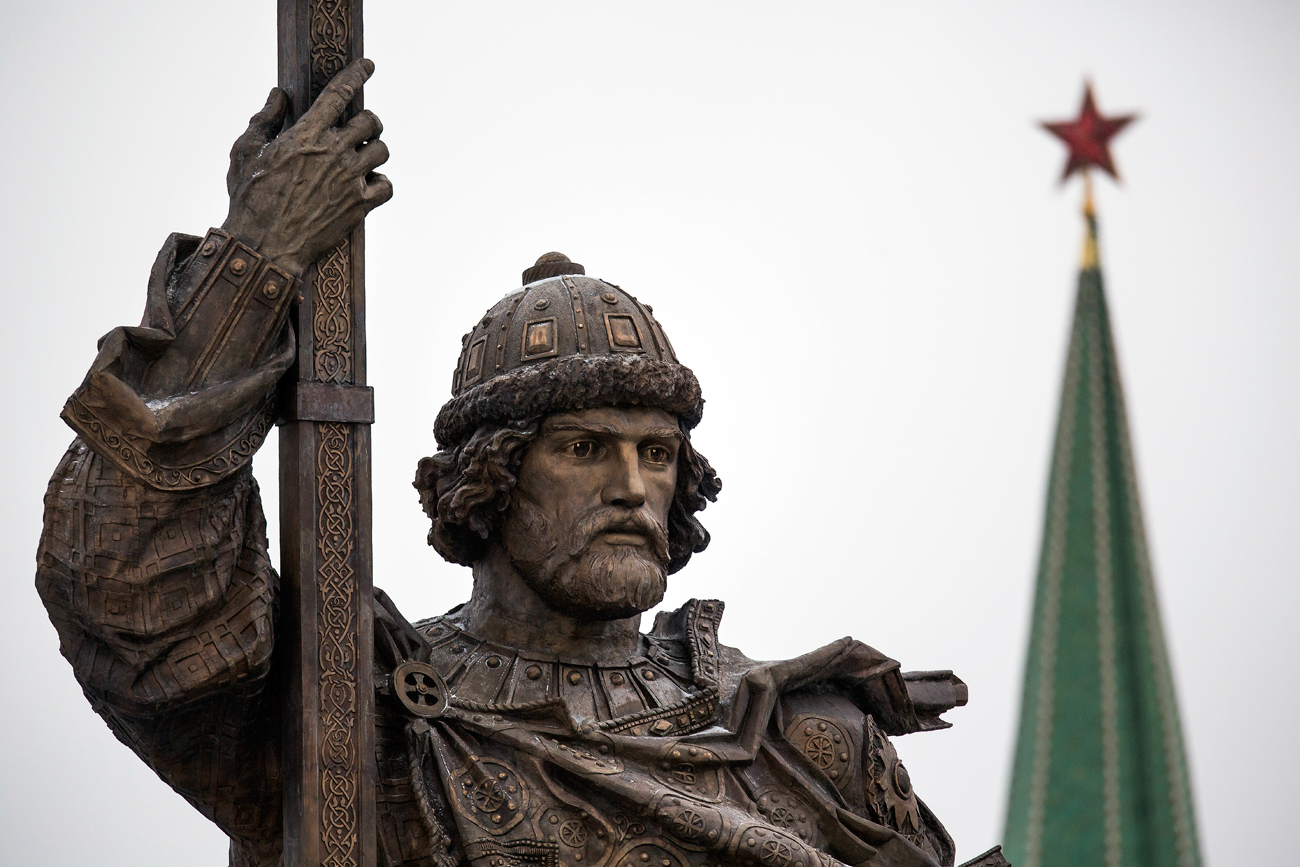By Dr. Vladislav B. Sotirović
In the years from 882 to 1242 the first and original national state organization of the Russians – the Kievan Russia (not Kyivan Rusia or Kyiv Rus’!) became directly and indirectly subject to external political influences by several external political units of the time. According to the official historiographical traditions (mainly of Western origin), Kievan Russia was established and governed by the Nordic Vikings (“Varyagi/Varangians/Rus’”) with the Dnieper as its axis with Kiev as capital and later received Christianity of the Eastern (Greek) type from the Byzantium in the south and was finally conquered by the barbaric Mongol Tartars from the east.
The origin of the term “rus’” is, actually, still not scientifically investigated and, therefore, clear (due to the lack of proper historical sources). However, in the early period of the state’s emergence, the Eastern Slavs did not use the term “rus’” to refer to themselves. The term is, in fact, related to the Old Norse word “rōþr”, which means a rower or a campaign by boats propelled by oars. In the 9th and 10th centuries, “rus’” referred to the ducal inner circle and his confidants, the army – an elite social group. In Byzantine written historical sources circulating until the 11th century, “rus’” (“Rhōs”) referred to the Scandinavians or the Nordic Vikings. Around that time another name, “Varangians” (“Varangoi”), also appeared. Varangians were primarily Nordic-Scandinavian mercenaries in the Byzantine Imperial army. They were elite warriors valued for their valor and loyalty and even formed the Emperor’s personal bodyguard. The terms “rus’” and “Varangians” have been used synonymously since the 11th century.
From the very point of geography, concerning the formation and functioning of the first state of the Eastern Slavs, on the territory of Kievan Russia, there was a contrast between seven types of land being of significant importance at the time: northern coniferous forest, tundra, mixed and deciduous forest, wooden steppe, steppes, desert, and mountain vegetation. The Nordic Vikings arrived in this region in the 9th century as merchants and conquerors but before that, the Slavic tribes living there were pushing eastwards from Central Europe toward the woodlands of present-day European Central Russia. However, at the same time, different types of Asiatic hordes belonging to nomadic horsemen have been constantly moving westwards across Russian southern steppes.
Nevertheless, when the Nordic Vikings arrived, the rivers in a north-south direction (not steppes in the eastern-western direction) became the focal routes of importance. The militant Vikings established, dominated, and consequently exploited chief waterways trade lines along the main rivers of the region populated by the Eastern Slavs from the Baltic Sea to the Black Sea including the Dnieper River as the focal waterway for the Viking-led trade with the Byzantine Empire. In fact, the first national state of Russians – Kievan Russia, originated in the Viking’s attempt to impose trade control over the territories around the main watersheds from the Baltic to the Black Sea. The chief trading potential between the Baltic and Byzantium comes from the fact that the rivers of the land populated by the Eastern Slavs have in general north-south and south-to-north directions of navigation.
As a matter of fact, in Kievan Russia, both the focal trade lines and coming state organization have been going from north to south, based upon the rivers, across the west-east belt of forest and steppe used by the Russian enemies in their invasion attempts from Asia to Europe. Actually, the whole history of Kievan Russia as the first national state of Russians, was politically dominated by the constant fight and ultimate failure of the Russians to protect their steppe land from the Asiatic migrating nomadic-warrior invaders. However, instead, Russians resumed the historic eastward colonization of the northern forest belt, which the Asiatic nomads did not dare to enter until the mid-13th century.
The focal river route that the Scandinavian Vikings used ran from the Gulf of Finland up the Neva River, via Lake Ladoga, the Volkhov and Dnieper Rivers, and across the Black Sea to the Byzantine Empire which had developed trade links with Asia. This trade line was known in historical sources of the time as the “route from the Varyagi to the Greeks” (i.e., from Scandinavia to Byzantium). The Vikings succeeded in imposing their military-political and economic control southwards and consequently, the towns of Smolensk, Novgorod, and Kiev (in 882) became controlled by them as the main trade outposts. Among all other towns, Kiev grew fast for the very reasons it was the capital of the state and it established strong economic links with the Byzantine Empire – its most important trading partner. In addition, Kievan Russia received the Orthodox Christian denomination at the time of the rule by Vladimir Svyatoslavich (980−1015).
During the Viking military and trading expeditions throughout the lands populated by the Eastern Slavs within the boundaries of Kievan Russia, the Khazars and Magyars (vassals of the Khazars) occupied the southern steppes north of the Black Sea, Sea of Azov, and the Caspian Sea. The Khazars, originally nomadic tribes, by the 10th century, became farmers and merchants who settled between the River Dnieper and the River Volga where they established powerful state organization. The Slavic Russians succeeded in controlling the territory north of the southern steppes of the lower rivers of Pruth, Southern Bug, and Dniester, and to keep control of the Dnieper route with the exit to the Black Sea. A Russian Grand Duke Svyatoslav (962−972) took an obligation to defeat the Khazars in order to expand the southern territory of its state and to neutralize the Khazar’s pressure on the borders of Kievan Russia. His army defeated Khazars and occupied their capital city of Sarkel in 965 continuing military expeditions in the next two years along the rivers of Volga, Terek, and Kuban between the Caspian Sea and Sea of Azov. In 966, the Volga Bulgars have been defeated as well. However, the crushing Khazars was a kind of trap as now it opened the way to the wild Pechenegi who consequently controlled the southern steppes between Dniester and Dnieper. However, in 1054 warlike Polovtsy living between Volga and Ural rivers started to move eastward crossing Volga and subordinated Pechenegi who sacked the city of Kiev in 1093. Grand Duke Vladimir I of Kiev (980−1015) was forced to organize some defensive actions against fierce Pechenegi.
Kievan Russia was always in trouble with the nomadic peoples in the southern steppes being weakened in constant conflicts with them – the problem was never solved till the end of the state independence in the mid-13th century. From 1054 up to its final dissolution in 1242, Kievan Russia was broken up into several autonomous and even, in fact, independent principalities which in many cases were in conflicts between themselves. The southern parts of Kievan Russia were suffering from cruel raids of plundering by Polovtsy and attacks by other nomadic peoples, while northern principalities (like Novgorod and Vladimir-Suzdal with Moscow) enjoyed their geographic positions of several watersheds trade lines in the security of the forests and marshes. Especially Novgorod on the River Volkov near Lake Ilmen became economically prosperous and established a vast fur-trading empire stretching to the Artic and the Ural Mt. Steady colonization of the forests in central and northern parts of Kievan Russia, giving them enough power to effectively get rid of the rule from Kiev. After the Novgorod trading empire, among all forest principalities, the most important was Vladimir-Suzdal with the fast-growing city of Moscow (first mentioned in historical sources in 1147).
The Vladimir-Suzdal principality on the eve of the final Mongol incursion into central Russian lands in 1237 was preparing to attack the Volga Bulgars (of Mongol origin) as their position in the mid-Volga region was a barrier for further Russian expansion toward the East. For that purpose was built Nizhniy Novgorod as a military stronghold (fortress) on the way of the campaign against the Volga Bulgars and their capital Bolgar on the Volga River. However, in 1237 started the Mongol invasion which was one of the most (if not the most) traumatic events in Russian history. Firstly, the Asiatic Mongols made an exploratory incursion into the southern Russian steppes in 1221 when they defeated the joined army of Russian and Polovtsy detachments at the Battle of the River of Kalka on May 31st, 1223. However, the Mongols as more powerful returned to Russian steppes in 1236 and first attacked the regions of middle and upper Volga against Volga Bulgars continuing in the next winter of 1237/1238 their incursions in central Russian principalities when the protective marshes, lakes, and rivers were frozen. Consequently, the Mongols destroyed prosperous towns in the principality of Vladimir-Suzdal, especially after the Battle of the River Sit on March 4th, 1238 when they defeated the Russian forces. The territory of Novgorod, including the city of Novgorod itself, was saved only due to the approach of spring weather when the snow and ice started to melt and, therefore, the Mongols dared not be caught by the thaw among Novgorod’s surrounding marshes. Nevertheless, the next year (1239) southwest portions of Kievan Russia suffered annihilation by the Mongols. The city of Kiev itself became sacked in 1240 followed by numerous other settlements.
The territory of Novgorod escaped the Mongol barbaric invasion and looting of the settlements but on the other hand at the same time had to refute constant military attacks from Nordic Swedes and Baltic German Livonian Order of Crusaders who wanted to drive Russia from the Baltic. Novgorod’s Duke Alexander (“Nevsky”) succeeded in beating both of them: first the Swedes on the River of Neva in 1240, and the German Crusaders on the ice of Lake Peipus in 1242 but he had to recognize the Mongol overlordship in the same year of 1242 that was marked as the final ending of the independent Kievan Russia. Nonetheless, the Mongol incursions on the Russian land and the final subjugation of Kievan Russia had serious and lasting multi-effects of economic, political, social, and cultural consequences which in some aspects can be visible even today. First, the peasants were oppressed by the heavy tribute paid to the Mongol masters and lost any hope of changing their social status for a long time. Second, the destruction of the most important urban settlements, where handicrafts had been developed, reduced national life to, in fact, an uncivilized level of existence. Third, the cancelation of the urban class paved the proper way to the later emergence of political Russian autocracy which in many patterns imitated its Asiatic-Mongolic-Tatarian masters.
Nonetheless, the Mongolian Tatars themselves after 1242 soon withdrew to the southern steppes. They limited their direct military interventions against Russian lands to punitive expeditions if it was necessary followed by the policy of appointment of local powerful tax-collectors. Such a situation existed till the mid-15th century when Russians started to liberate their lands against Mongol lords.
Personal disclaimer: The author writes for this publication in a private capacity which is unrepresentative of anyone or any organization except for his own personal views. Nothing written by the author should ever be conflated with the editorial views or official positions of any other media outlet or institution.

